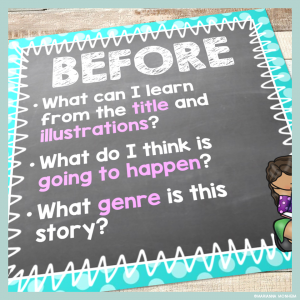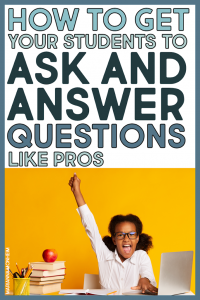ook out fore
If you’ve spent any time around elementary-aged students, you know that they LOVE to ask questions, but that doesn’t always translate into knowing how to ask the right kinds of questions while reading. However, with a little bit of scaffolding, and a lot of practice, your students can become questioning pros in no time!
CCSS RL.3.1 asks students to “ask and answer questions to demonstrate understanding of a text, referring explicitly to the text as the basis for the answers.” It is the first literature standard with good reason since students need to have a solid foundation in asking and answering questions before they can tackle the other standards with ease.
The best way to help students understand this standard is by explicitly teaching them the types of questions that can be asked while reading a piece of literature. Once students understand the different question types, and at what part of the reading process, they will encounter them, they are on their way to genuinely comprehending the text. Not to mention, if they become proficient with ASKING skilled questions, it will be that much easier for them to ANSWER comprehension questions, whether they are on a chapter quiz or a standardized test.
Types of Questions
Here are some of the types of questions students should l reading:
- Questions asked Before, During, and After reading: Each of these question types serves a particular purpose during the reading process. Questions asked before reading help students make predictions and activate prior knowledge that may help them understand the text. Questions asked during reading aid in their understanding of the story and also help them to self-monitor their comprehension and check for any misunderstandings. After reading, questions are geared toward evaluating the text and determining if the questions asked before reading were answered.
- The 5Ws (and 1H): Who, what, when, where, why, and how…these questions form the backbone of reading comprehension. These questions help our students understand what they read, and they must learn how to use these stems to ask quality questions as well as be able to answer them. For example, if you were doing a read aloud and asked a student for an example of a good “why” question, you would want to hear something like, “Why did Amelie’s friends ignore her at recess?” rather than “Why is Amelie wearing a red shirt?”
- Thick and Thin Questions: Students need to know the purpose of both thick and thin questions while they read. Thin questions are “right there” questions that can be answered by looking at a specific part of the text, while thick questions take a little bit more work to answer. To answer a thick question, students may have to look in several areas of the text or make an inference.
As students become familiar with the different types of questions, it is beneficial for them to have question stems readily available. This poster set provides visuals for all of the different types of questions, as well as question stems to help students get started. Students in my class referred to these posters often as they worked on crafting quality questions!
 |
| Displaying question stems is important as students learn how to develop meaningful questions on their own. |
As students learn to ask thoughtful questions, they need to understand that not all questions have one right answer and that many questions they have may not be answered just by looking in the text. It is also important for students to understand the role of questioning is to help them to understand the text they are reading better, so the types of questions they ask need to focus on important details about the characters and setting, and how those details affect the plot.
Scaffolded Practice
As students learn how to ask and answer questions like pros, they need a lot of practice! Of course, one way to get that practice is during your read alouds, but you also want your students to practice this skill with the texts they are reading, whether with you in a small group or on their own. However, your students may need a lot of help figuring out how to ask the “right” types of questions while they read. They will need more than a direction to “read pages ___ to ___ and write down any questions you have.”
A game-changer for my classroom was graphic organizers focused on specific questioning skills. These graphic organizers have differentiated options so that each child in my class could receive the level of support they needed to craft meaningful questions. These were a great option for independent reading, and significantly reduced the number of “Why are the letters on the cover blue?”-type questions I would get when I sent students off on their own.
Question trackers are a great way to get students started with asking their own questions while reading. Grab two free question trackers in my TpT store!
Independent Practice
Although providing scaffolding is important, at the end of the day students need to be able to demonstrate an understanding of how to ask solid questions on their own. Here are some fun, creative activities that will help students practice asking and answering questions independently:
- Creating a poster of questions they have before, during, and after reading a selected text
- Writing a play where the characters can only communicate by asking questions
- Write a song that explains the differences between thick and thin questions
These activities and more are included in my Ask and Answer Questions Choice Board. The choice board includes activity sheets for the tasks described above, as well as student directions for each activity and a rubric. I love assigning this choice board after my questioning unit because it gives students a chance to be creative and allows me to see if they truly understand the concept of asking and answering questions!
You can grab all of the products mentioned in this post at a 25% discount with the Ask and Answer Questions bundle! The activities mentioned work well with both in-person and distance learning.
How do you get your students to ask meaningful questions while reading?




